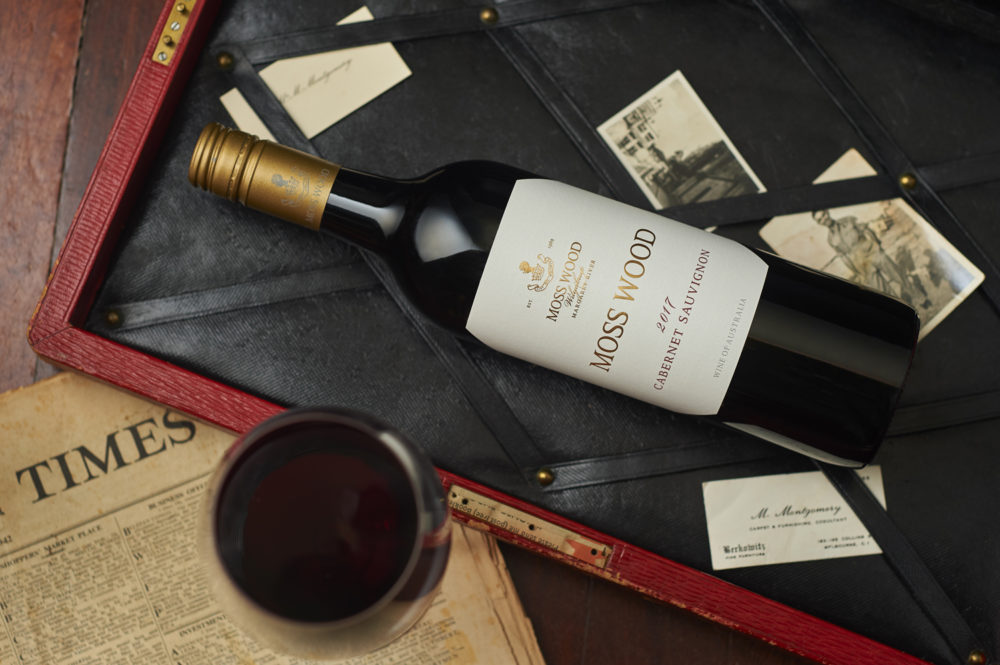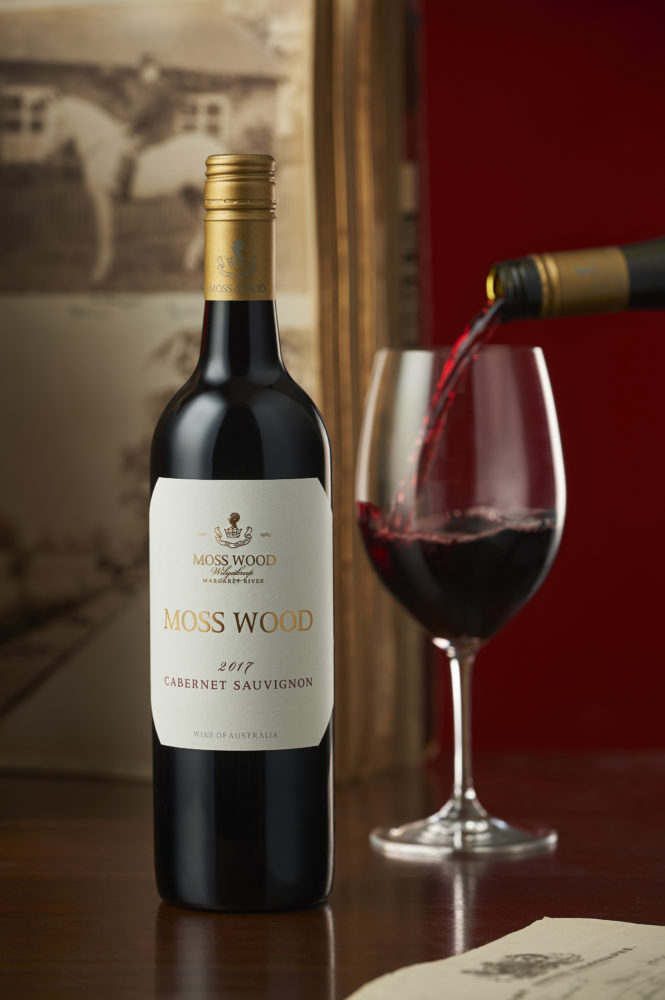MOSS WOOD NEWSLETTER Autumn NEWS ISSUE #106 march 2020
MOSS WOOD 2017 CABERNET SAUVIGNON

VINTAGE NOTES
As we said, it’s a fine line and we are entirely in the hands of Mother Nature. In 2017 she made plenty of idle threats but in the end took pity on the humble grapegrowers of Margaret River and delivered a classic, West Coast Indian Summer. We couldn’t have done any better if we’d written the script ourselves.
Aside from the generally low temperatures discussed above, we had drizzly weather during flowering and 16 days when minima were below the crucial 8°C. These cool nights were right at the beginning of the process, so appear to have done little harm, with yield for Cabernet Sauvignon being only very slightly below average. There was a 39mm dump of rain that came on 12th December which didn’t help matters but at least on that day the temperatures weren’t too low.
Through January we experienced delightful conditions, if somewhat mild. The mean temperature of 19.5°C was nearly 1° below average, so beach days were at a bit of a premium. February was similar and during the second week we also received 22mm of rain which freshened things up. It was during March when we started to have Chrissie Amphlett ringing in our ears, when we racked up 81mm of rain. Yes, with the arrival of autumn we expect to see some showers but not necessarily quite that much.
At this stage, the late flowering and mild temperatures were beginning to loom large. Moss Wood Cabernet Sauvignon needs at least 1100 hours where the temperature is between 18 and 28°C to reach full ripeness but by the end of March, it had received 1046 and astute readers will note that to achieve the additional 50+ hours, we needed another 10 bright sunny days.
At this point Mother Nature had a complete change of heart. The sun shone and most importantly, the rain stopped and we started picking Cabernet Sauvignon in the second week of April, at 13.0° Baume and with full flavour ripeness after 1120 hours of ripening under its belt.
Meanwhile, the blending varieties were going about their business. Cabernet Franc came off on 4th April at a very creditable ripeness of 13.9° Baume, followed 11 days later by Petit Verdot at an even more impressive 13.9 Baume. Who would have known it had been so mild?
Yields across the 3 varieties were varied. At 4.39 tonnes per hectare, Cabernet Franc was down 26% but Cabernet Sauvignon was virtually spot on its average at 7.37 tonnes per hectare and Petit Verdot went ballistic. Its yield of 7.25 tonnes per hectare was an amusing 32% above average. We don’t often get the chance to write a statement like that.
Production Notes
All the fruit was hand-picked and delivered to the winery where it was destemmed and placed in small, open fermenters. Each batch was seeded with multiple yeast strains and hand-plunged three times per day for extraction. Time on skins was typically 14 days, although one batch was pressed after a rare 22 days in the fermenter. As always, each one was tasted daily and pressed according to taste.
In May 2017, after malolactic fermentation in stainless steel tanks, each batch was racked to wood. All barrels were 228 litre French oak and 15% were new. In November 2018 all the individual batches were racked and blended for the first time. The final makeup of the assemblage was 88% Cabernet Sauvignon, 8% Petit Verdot and 4% Cabernet Franc.
People familiar with the traditional Moss Wood Cabernet Sauvignon blend will note the higher percentage of Petit Verdot than is usual. As we noted above, we had a surprisingly high yield. We had no hesitation including it in the blend because the mighty 2001 was 89%, 7% and 4%, respectively. We were more than happy with how that turned out.
In October 2019 the wine was racked from barrel for the final time and we conducted fining trials to see if we could improve the tannin balance but no fining was necessary. It was then sterile filtered and bottled on 1st Nov, 2019.
Wine Facts
| Harvest Dates: | Cabernet Sauvignon – 10/4/2017 Cabernet Franc – 4/4/2017 Petit Verdot – 15/4/ 2017 |
| Harvest Ripeness: | Cabernet Sauvignon 13.0° Baume Cabernet Franc 13.9° Baume Petit Verdot 13.9° Baume |
| Yields: | Cabernet Sauvignon – 7.37t/ha Cabernet Franc – 4.39t/ha Petit Verdot – 7.25t/ha |
| Growing Season Average Temperature: |
18.9⁰C |
| Ripening time from flowering to harvest: | Cabernet Sauvignon – 122 days Cabernet Franc – 123 days Petit Verdot - 130 days |
| Oak maturation: | 31 months |
| Bottled: | 04/11/2019 |
| Released: | 04/05/2020 |
| Alcohol: | 14% |

Tasting Notes
Nose
A classic Cabernet combination of blueberries, violets, blackberries with tar and cedar notes. The musky, black fruit note also suggests the higher percentage of Petit Verdot this year. There’s also pencil shavings and pomegranate and a very light toasty oak.
Palate
In the traditional Moss Wood style, the first impression here is one of bright, generous blue and black fruit flavours, sitting over concentrated but balanced tannin. It’s the classic vineyard statement. However, there are also some pointers to the 2017 season, with crisp acidity, giving the palate a taut, almost zippy feel. The finish is firm, with a very light touch of toasty oak, mixing with cedar and tar.
Cellaring
Apparently, Mark Twain once said history never repeats itself but it often rhymes and we reckon grape growing seasons are a classic example. Moss Wood followers will know we’re fond of reminiscing about vintages past and how they compare with current releases and yes, it’s a useful way to give perspective on wine style and cellaring potential. With the 2017 we turn immediately to the 1990 because these two share some remarkable similarities. Both were mild growing seasons with plenty of rain and in March, not only were the dates similar but also the amounts. It resulted in similar ripeness, 13.0 Baume in 2017 compared with 12.8 in 1990, and harvest with the former picked on 10th April and the latter on the 12th. Most importantly, this means we have great expectations of the 2017 because its older sibling remains one of Moss Wood’s finest that continues to drink well 30 years later. At present, the wine is showing vibrant fruit aromas so it’s an appealing youngster and can certainly be enjoyed now. However, the underlying structure is firm and will support long term aging, just as it did for the 1990. Over the next decade it should begin to soften but it will take until at least 20 years of age before it reaches full maturity.
Colour and condition
Deep brick red, in bright condition.
reviews
Joe Czerwinski- Robert Parker Wine Advocate reviews Moss Wood 2017 Cabernet Sauvignon
"Marked by notes of ripe cherries, red-skinned plums and hints of cassis, the 2017 Cabernet Sauvignon was being bottled the day of my visit, so I tasted it from tank. It's medium to full-bodied, with silky tannins and a long, long finish. While previous vintages showed more oak influence, this (and the 2018 and 2019) show a more nuanced touch and barely noticeable cedar and vanilla shadings."
Vintage 2020
Vintage 2020 - Moss Wood Pinot Noir
2020 Growing Season
It’s hard to know where to start with all this. The bushfires in southeastern Australia have caused horrific damage in some of the vineyard regions and the losses to fire and smoke taint are yet to be fully calculated. Some of the stories have been heart-rending and our hearts go out to all who have borne the brunt of Mother Nature’s full force.
Fortunately, not every wine area has been badly affected and no doubt there are going to be some good news stories emerging as the harvest comes in. We hear hopeful stories from our colleagues interstate and hope they continue.
In Margaret River we’re counting our blessings. Mother Nature has, so far, been in a benign mood and spared us any serious challenges. Readers will note the use of “so far”, a classic farming response. At the time of writing, we’re in the home straight, with Moss Wood due to be finished by 24th March and Ribbon Vale soon after.
After 3 very mild summers, this year we have enjoyed a more typical season. Temperatures have been closer to average and this, combined with early flowering, means we’re roughly 10 days ahead of average. We’re delighted to report all varieties are showing excellent quality but sadly, yields are well down, with Pinot Noir the worst offender, being 70% below average. The others are not as bad but we’re expecting to be down around 30-40% overall.
The local redgum eucalypts have produced an abundance of blossom in 2020 and this has kept the birds away from the grapes, at least until the last 3 weeks or so. Since then flowering has all but ceased and some very hungry silver eyes have turned up in the vineyards looking for grapes. Our nets have done a good job of keeping them at bay, although their hunger is now causing them to attack the nets and they’re getting through even the smallest of holes. They have just about outstayed their welcome!
As much as we’re forever optimistic, we knew crops were unlikely to be big this year because we experienced a significant hailstorm in the very early hours of 24th Oct 2019. When we inspected the vineyard there was significant damage, with shoot tips cut off and canes badly bruised. Little wonder the crop was reduced and as we like to say around here, a good hailstorm will do that.
We want to reiterate the important point - quality is very impressive, with strong similarities to 1995 and 2003. We look forward to showing the 2020 wines off as they roll through over the next 3 years.
Vintage Crew
Assisting the Moss Wood regulars, Matthew Wood, Henry Hewitson and Liam Burkhardt, we’ve got an eclectic group of budding young winemakers. Ryan Donnelly and Reilly Jones, are both 4th year Bachelor of Viticulture and Oenology students at Adelaide University. Ryan is a Mornington Peninsula lad and we’ve been showing him how Pinot Noir and Chardonnay should be made. Reilly is an old scholar of Adelaide’s venerable Westminster School, as is Keith and who also worked in the latter’s home town of McLaren Vale at Wirra Wirra. We’ve worked hard to discourage the bad habits learned in both places. Marie Houlette, an Agricultural Engineering graduate from Supagro at the National Institute of Agronomy at Montpellier University, is the second person from that esteemed institution to work with us, the original being Marie Charlemagne in 2018. Caroline Gass, the first native of Alsace to do a Moss Wood vintage, is a Bachelor of Agronomy from Brabois University of Technology at Nancy and is currently studying for her Master’s Degree in Vine, Wine and Terroir at the University of Dijon. Last but not least is Cristina Piumatti, from Piemonte in Italy and a Bachelor of Viticulture and Oenology from the University of Turin. Cristina has an interesting history having worked in the Mosel Valley in Germany for Weingut Weiser-Kunstler and most recently at Vinedos Don Leo, in Parras de la Fuente, Coahuila in Mexico. Mexican work experience is a definite first for Moss Wood and Cristina walks around in a most stylish Mexican hat when out in the vineyard.
Order
OUR WINES:
Contact
MOSS WOOD:
Location: 926 Metricup Road, Wilyabrup WA
Postal: PO Box 225, Cowaramup WA 6284
Phone: +61 8 9755 6266
Fax: +61 8 9755 6303
Follow us on
SOCIAL MEDIA:
